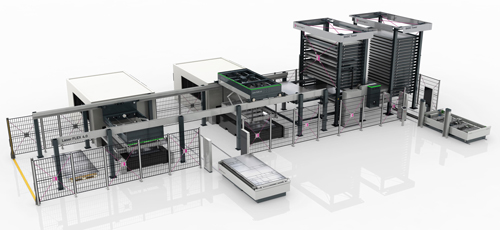“A loading and unloading system compatible with all laser cutting systems ensures maximum investment security,” he says.
Modularity is another factor when selecting automated material-flow solutions. A system of modular, versatile elements can be expanded, meaning that fabricators receive a tailored system that can be upgraded at any time with the addition of new components.
Once fabricators have enhanced their productivity and become more competitive through initial automation processes, they then have the flexibility to increase the level of automation and expand their production systems through the addition of various modules, reasons Baudach.
Ask the Right Questions to Get the Right Automation Answer
For Remmert’s part, “we always take a look at the entire process, not just the capacity the cutting machine systems are running at,” says Baudach.
This means analyzing each existing layout and the fabricator’s production requirements. Numerous factors come into play here. What level of productivity is the customer looking to achieve? Which materials must be processed? And in what quantity? What staffing capacities are available? And how can the machinery be arranged most efficiently? With these questions answered, a material-flow concept is drawn up.
The goal: “Continuous flow of sheet metal across the board—from incoming goods through processing and onto outgoing goods,” explains Baudach.
Achieving the reality of an agile material flow may entail solutions ranging from simple handling to fully automatic operation.Baudach cites Remmert’s LaserFlex system as an example of a fully automated process, where the system simultaneously can load and unload raw materials from as many as four laser cutting machines—at speeds of 60 sec. per machine—no matter the manufacturer of those machines.
“This enables companies to ensure that their high-speed laser cutting machines run at maximum capacity,” says Peitz.
Adding a material-storage tower may deliver even greater efficiency, as warehouse automation is a suitable solution for storing raw materials and buffer stock that has undergone the cutting process.
“If the finished parts are stored at night and sorted by staff the next morning, laser cutting machines can operate around the clock, which shortens return on investment,” Peitz explains.
By adding automated storage and a conveyor, finished parts can be sorted by hand after cutting or removal from a tower as part of a simple process.
Central Control Brings Benefits
Managing and operating all of these processes centrally adds to the system’s functionality.
“You can have the best automation solution around, but it’s not much good if the information required for effective and agile material flow is either not available or not utilized correctly,” explains Baudach.
Seamlessly integrated software, such as Remmert’s Smart Control, can handle the entire production and material-handling process.
As we’ve read, automation of sheet metal processing offers much potential. However, before this potential can be harnessed, material flows must be aligned with individual production processes. This is how production efficiency can be enhanced.
“Users should bank on manufacturer-independent systems that offer modular expansion options and thus provide an innovative form of investment security,” concludes Baudach. “This helps customers remain flexible.” MF
Article supplied by Remmert GmbH, Lohne, Germany; www.remmert.de/en/, e-mail info@remmert.de.
See also: Remmert GmbH
Technologies: Cutting, Pressroom Automation









